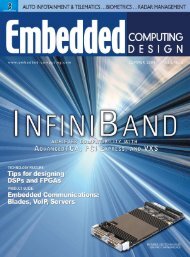CompactPCI and AdvancedTCA Systems - OpenSystems Media
CompactPCI and AdvancedTCA Systems - OpenSystems Media
CompactPCI and AdvancedTCA Systems - OpenSystems Media
You also want an ePaper? Increase the reach of your titles
YUMPU automatically turns print PDFs into web optimized ePapers that Google loves.
APPLICATIONFor base stations implementing these new data service requirements,which support the higher speeds dem<strong>and</strong>ed by the downlink(HSDPA) <strong>and</strong> uplink (High-Speed Uplink Packet Access, orHSUPA, technologies coming in a future 3GPP release) speeds,baseb<strong>and</strong> throughput, <strong>and</strong> processing power must increase.Processing power must grow to support the additional algorithmicrequirements driven by the data service requirements <strong>and</strong>by an increasing number of users per base station. These designrequirements dictate the use of components, such as FPGAs, thatcan effectively support single-chip parallel processing operations,as ASICs are not flexible enough for cost-effective deployment.Designers can effectively use FPGAs in the baseb<strong>and</strong> modules ofthe wireless base station to implement the required performancelevels. Using parallel processing techniques enables leveragingdedicated integrated signal processing functional blocks. Thesecapabilities allow for flexible solutions that help reduce chipcount <strong>and</strong> lower power inside the baseb<strong>and</strong> module.Reducing base station operating costs usingprogrammabilityFPGA programmability can also help significantly lower operatingcosts by offering operators increased power efficiencies duringoff-peak times. Wireless operators need to deploy enough basestations <strong>and</strong> remote radio antennas to support traffic loads duringpeak usage times. If the operator cannot support a h<strong>and</strong>set user’srequest for a connection when the network is heavily loaded, thenthis service quality issue may drive the user to switch to anotherservice. Thus wireless operators are forced to either sufficientlybuild out their own network to support peak loading times or rentenough usage time from an existing infrastructure to meet theirpeak loading needs. For reference purposes, a typical wirelessbase station network is depicted in Figure 1.Figure 1Not surprisingly, the traffic load on a wireless network decreasessignificantly during the late night <strong>and</strong> early morning hours. Incertain locations, the traffic load also decreases on the weekends<strong>and</strong> holidays as well. This loading imbalance makes it possiblefor wireless operators to balance their network during this time.To successfully implement a power-balancing configuration, thewireless base stations must contain the flexibility to perform thefollowing energy saving sequence:1. Do not accept any new transactions.2. Complete all existing transactions.RSC# 45 @www.compactpci-systems.com/rsc<strong>CompactPCI</strong> <strong>and</strong> <strong>AdvancedTCA</strong> <strong>Systems</strong> / June 2005 / 45
















